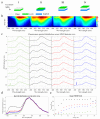Multispectral Depth-Resolved Fluorescence Lifetime Spectroscopy Using SPAD Array Detectors and Fiber Probes
- PMID: 31200569
- PMCID: PMC6631026
- DOI: 10.3390/s19122678
Multispectral Depth-Resolved Fluorescence Lifetime Spectroscopy Using SPAD Array Detectors and Fiber Probes
Abstract
Single Photon Avalanche Diode (SPAD) arrays are increasingly exploited and have demonstrated potential in biochemical and biomedical research, both for imaging and single-point spectroscopy applications. In this study, we explore the application of SPADs together with fiber-optic-based delivery and collection geometry to realize fast and simultaneous single-point time-, spectral-, and depth-resolved fluorescence measurements at 375 nm excitation light. Spectral information is encoded across the columns of the array through grating-based dispersion, while depth information is encoded across the rows thanks to a linear arrangement of probe collecting fibers. The initial characterization and validation were realized against layered fluorescent agarose-based phantoms. To verify the practicality and feasibility of this approach in biological specimens, we measured the fluorescence signature of formalin-fixed rabbit aorta samples derived from an animal model of atherosclerosis. The initial results demonstrate that this detection configuration can report fluorescence spectral and lifetime contrast originating at different depths within the specimens. We believe that our optical scheme, based on SPAD array detectors and fiber-optic probes, constitute a powerful and versatile approach for the deployment of multidimensional fluorescence spectroscopy in clinical applications where information from deeper tissue layers is important for diagnosis.
Keywords: CMOS; SPAD; depth-resolved fluorescence; fiber optics; fluorescence lifetime; fluorescence spectroscopy; tissue diagnosis.
Conflict of interest statement
The authors declare no conflict of interest.
Figures




Similar articles
-
Real-time multispectral fluorescence lifetime imaging using Single Photon Avalanche Diode arrays.Sci Rep. 2020 May 15;10(1):8116. doi: 10.1038/s41598-020-65218-3. Sci Rep. 2020. PMID: 32415224 Free PMC article.
-
A Point-of-Care Device for Molecular Diagnosis Based on CMOS SPAD Detectors with Integrated Microfluidics.Sensors (Basel). 2019 Jan 22;19(3):445. doi: 10.3390/s19030445. Sensors (Basel). 2019. PMID: 30678225 Free PMC article.
-
Characterization of a Time-Resolved Diffuse Optical Spectroscopy Prototype Using Low-Cost, Compact Single Photon Avalanche Detectors for Tissue Optics Applications.Sensors (Basel). 2018 Oct 29;18(11):3680. doi: 10.3390/s18113680. Sensors (Basel). 2018. PMID: 30380688 Free PMC article.
-
Single Photon Avalanche Diode Arrays for Time-Resolved Raman Spectroscopy.Sensors (Basel). 2021 Jun 23;21(13):4287. doi: 10.3390/s21134287. Sensors (Basel). 2021. PMID: 34201576 Free PMC article. Review.
-
Compact SPAD-Based Pixel Architectures for Time-Resolved Image Sensors.Sensors (Basel). 2016 May 23;16(5):745. doi: 10.3390/s16050745. Sensors (Basel). 2016. PMID: 27223284 Free PMC article. Review.
Cited by
-
A Sensitive Fibre Optic Probe for Autofluorescence Spectroscopy of Oral Tongue Cancer: Monte Carlo Simulation Study.Biomed Res Int. 2020 Apr 8;2020:1936570. doi: 10.1155/2020/1936570. eCollection 2020. Biomed Res Int. 2020. PMID: 32337228 Free PMC article.
-
A Bright and Colorful Future for G-Protein Coupled Receptor Sensors.Front Cell Neurosci. 2020 Mar 20;14:67. doi: 10.3389/fncel.2020.00067. eCollection 2020. Front Cell Neurosci. 2020. PMID: 32265667 Free PMC article.
-
Real-time multispectral fluorescence lifetime imaging using Single Photon Avalanche Diode arrays.Sci Rep. 2020 May 15;10(1):8116. doi: 10.1038/s41598-020-65218-3. Sci Rep. 2020. PMID: 32415224 Free PMC article.
-
Fluorescent Chemosensors in the Creation of a Commercially Available Continuous Glucose Monitor.ACS Sens. 2024 Dec 27;9(12):6320-6326. doi: 10.1021/acssensors.4c02403. Epub 2024 Nov 25. ACS Sens. 2024. PMID: 39584534 Free PMC article.
References
-
- Gillenwater A., Jacob R., Ganeshappa R., Kemp B., El-Naggar A.K., Palmer J.L., Clayman G., Mitchell M.F., Richards-Kortum R. Noninvasive diagnosis of oral neoplasia based on fluorescence spectroscopy and native tissue autofluorescence. Arch. Otolaryngol. Head Neck Surg. 1998;124:1251–1258. doi: 10.1001/archotol.124.11.1251. - DOI - PubMed
-
- Yuvaraj M., Udayakumar K., Jayanth V., Prakasa Rao A., Bharanidharan G., Koteeswaran D., Munusamy B.D., Murali Krishna C., Ganesan S. Fluorescence spectroscopic characterization of salivary metabolites of oral cancer patients. J. Photochem. Photobiol. B Biol. 2014;130:153–160. doi: 10.1016/j.jphotobiol.2013.11.006. - DOI - PubMed
Grants and funding
LinkOut - more resources
Full Text Sources

